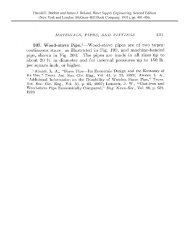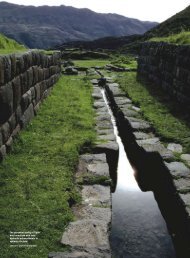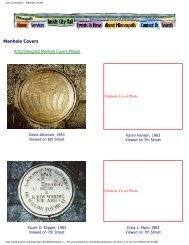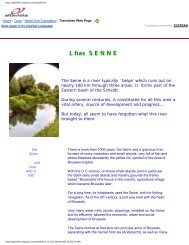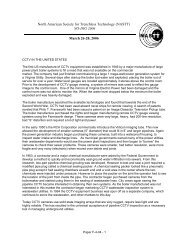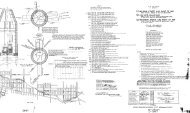The Water Supply and Distribution System of the Nabataean City of ...
The Water Supply and Distribution System of the Nabataean City of ...
The Water Supply and Distribution System of the Nabataean City of ...
Create successful ePaper yourself
Turn your PDF publications into a flip-book with our unique Google optimized e-Paper software.
Charles R. Ortl<strong>of</strong>f<br />
Figure 3. Elevated water channel/piping system on west face <strong>of</strong> El Khubtha<br />
Mountain.<br />
that collected from rainfall run<strong>of</strong>f for urban housing<br />
needs <strong>and</strong> rituals at nearby tomb complexes. While<br />
run<strong>of</strong>f capture probably supplied <strong>the</strong> Zurraba reservoir,<br />
local spring sources, including Ain Mousa, were<br />
also important in <strong>the</strong> early phase <strong>of</strong> city development<br />
<strong>and</strong> may have also contributed water to <strong>the</strong> reservoir.<br />
Although reservoir water could be used to supplement<br />
<strong>the</strong> Siq channel, Ain Mousa water supplies were later<br />
switched to a piping system <strong>and</strong> <strong>the</strong> open channel<br />
was ab<strong>and</strong>oned. Rainfall run<strong>of</strong>f <strong>and</strong> spring flow still<br />
enabled <strong>the</strong> Zurraba reservoir to supplement <strong>the</strong> Siq<br />
pipeline when required. Although <strong>the</strong> modern town<br />
has obliterated ancient hydraulic connections to <strong>and</strong><br />
from <strong>the</strong> reservoir, <strong>the</strong>re is no topographical constraint<br />
to a channel path which would have directed reservoir<br />
water into <strong>the</strong> open channel (or into a later pipeline<br />
system) to provide supplementary water supply. <strong>The</strong><br />
Jebel el Khubtha pipeline, by contrast, appears to be<br />
<strong>the</strong> main outflow path for reservoir water in <strong>the</strong> area<br />
between Jebel el Khubtha <strong>and</strong> Wadi Mataha (B;2, C;2).<br />
Surplus water, after filling <strong>the</strong> cistern, was directed to<br />
<strong>the</strong> main city fountain (Nymphaeum 42, B;2) through<br />
ei<strong>the</strong>r a pipeline or subterranean channel. Although no<br />
traces <strong>of</strong> this connection have been excavated, pipeline<br />
fragments in <strong>the</strong> area suggest this connection. From<br />
a systems point <strong>of</strong> view, <strong>the</strong> Zurraba reservoir served<br />
principally to maintain cistern levels in <strong>the</strong> royal tomb<br />
area by intermittent water release. <strong>The</strong> Ain Mousa<br />
spring, on <strong>the</strong> o<strong>the</strong>r h<strong>and</strong>, provided <strong>the</strong> continuous<br />
supply for <strong>the</strong> Nymphaeum through piping supported<br />
in a carved channel through <strong>the</strong> Siq (Figs. 5a & b) that<br />
replaced <strong>the</strong> earlier open channel. <strong>The</strong> Zurraba reser-<br />
98<br />
voir thus served as a backup system<br />
for rapid delivery <strong>of</strong> large volumes<br />
<strong>of</strong> water at short notice to <strong>the</strong> Jebel el<br />
Khubtha cisterns <strong>and</strong> served to augment<br />
<strong>the</strong> continuous, but declining,<br />
water supply to <strong>the</strong> Nymphaeum<br />
from <strong>the</strong> Ain Mousa spring during<br />
dry seasons. <strong>The</strong> ability to provide<br />
an ‘on-dem<strong>and</strong>’ water supply from<br />
this backup source would have<br />
been most useful to large caravans<br />
entering <strong>the</strong> city that would place<br />
a sudden dem<strong>and</strong> on water supply<br />
<strong>and</strong> usage.<br />
Pipeline carrying capacity<br />
considerations: <strong>the</strong> Zurraba-Jebel<br />
el Khubtha system<br />
While a spring produces a given<br />
volumetric flow rate, <strong>the</strong> limitation<br />
on how much can be transported by pipeline stems<br />
from its technical characteristics (diameter, internal<br />
roughness, slope <strong>and</strong> supply head). Piping design<br />
requires <strong>the</strong> spring output flow rate to match (or<br />
be less than) <strong>the</strong> <strong>the</strong>oretical carrying capacity <strong>of</strong> <strong>the</strong><br />
pipeline. Examination <strong>of</strong> <strong>Nabataean</strong> pipeline designs<br />
yields insights into <strong>the</strong>ir ability to underst<strong>and</strong> internal<br />
pipeline flow phenomena, <strong>and</strong> to construct solutions<br />
to overcome problems limiting maximum throughput.<br />
For an upper estimate <strong>of</strong> <strong>the</strong> volumetric flow rate that<br />
<strong>the</strong> Jebel el Khubtha pipeline system could sustain,<br />
it is assumed that <strong>the</strong> angle <strong>of</strong> about 0.005 shown by<br />
<strong>the</strong> elevated channel supporting <strong>the</strong> pipeline (Figs. 1<br />
& 3) corresponds to <strong>the</strong> critical flow angle (Morris &<br />
Wiggert 1972). <strong>The</strong> maximum flow height within <strong>the</strong><br />
piping is at critical depth equal to perhaps 50 per cent<br />
or more <strong>of</strong> <strong>the</strong> pipe diameter. This condition means<br />
that water flows in open channel mode through <strong>the</strong><br />
piping, with an airspace above <strong>the</strong> water surface, <strong>and</strong><br />
that <strong>the</strong> flow rate is maximum for given diameter <strong>and</strong><br />
slope. This type <strong>of</strong> hydrostatically unpressurized flow<br />
reduces leakage between socketed pipeline elements,<br />
while providing <strong>the</strong> <strong>the</strong>oretical maximum flow rate for<br />
low angle piping functioning in ei<strong>the</strong>r open channel or<br />
full flow mode. <strong>The</strong> maximum flow rate permissible<br />
<strong>the</strong>n would be <strong>the</strong> critical velocity x piping wetted<br />
cross-sectional area. For a fall in channel height <strong>of</strong><br />
about 40 m over <strong>the</strong> 8 km pipeline path around Jebel<br />
el Khubtha, <strong>the</strong> <strong>the</strong>oretical maximum volumetric flow<br />
rate is about 90 m 3 /hr for 20 cm diameter piping. In<br />
practice, owing to <strong>the</strong> many mortared joints between<br />
<strong>the</strong> 0.3 m terracotta piping segments (perhaps <strong>of</strong>



